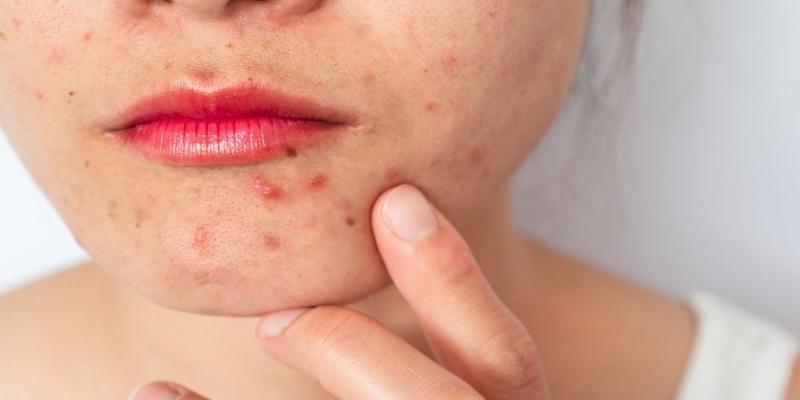Understanding Black Spots on Your Lips: 9 Causes You Should Be Aware Of
Jul 26, 2024 By Madison Evans
Finding black spots on your lips can be concerning. These dark patches can vary in size and appearance, and while some causes are harmless, others may require medical attention.

Understanding the potential reasons behind these spots can help you address any underlying issues and maintain healthy skin. Let's explore the nine possible causes of black spots on your lips and what you can do about them.
Lips with Black Spots? Explore These 9 Potential Causes
Hyperpigmentation
Hyperpigmentation is a common cause of black spots on lips. This condition occurs when an excess of melanin, the pigment responsible for skin color, forms deposits in the skin. Factors like sun exposure, hormonal changes, and certain medications can trigger hyperpigmentation. To manage this, use sunscreen regularly, limit sun exposure, and consult a dermatologist for appropriate treatments, such as topical creams or laser therapy.
Hyperpigmentation can be particularly noticeable on the lips because the skin there is thinner and more sensitive. It can also be exacerbated by habits such as licking your lips frequently, which can lead to irritation and further pigmentation.
Lip Trauma
Dark spots can result from lip injuries. Biting your lip, consuming hot foods or drinks, or blowing your mouth can cause trauma, often resulting in a blood blister or a darkened area during the healing process. These spots generally fade as the injury heals. However, if the spots persist or worsen, it is advisable to seek medical advice to rule out other potential conditions.
Trauma-induced pigmentation can also occur from dental procedures or even aggressive teeth brushing. If the trauma is repeated or the area is not allowed to heal properly, the pigmentation might become permanent.
Smoking
Smoking is another cause of black spots on your lips. The chemicals in tobacco can damage the delicate skin of the lips, leading to pigmentation changes. Over time, smokers often develop darker lips and may notice black spots. Quitting smoking can improve your overall skin health and reduce the appearance of dark spots.

Nicotine and tar from cigarettes can lead to the formation of melanin, which results in hyperpigmentation. Besides quitting, switching to less harmful habits and using lip care products designed to detoxify and nourish the lips can help in reversing some of the pigmentation effects over time.
Allergic Reactions
Allergic reactions to certain lip products, such as lipsticks, balms, or glosses, can lead to dark spots. Ingredients like dyes, fragrances, and preservatives can irritate the lips, causing pigmentation changes. If you suspect an allergic reaction, discontinue the use of the product and switch to hypoallergenic alternatives. Consulting with a dermatologist can also help identify the specific allergen.
Patch testing is an effective way to identify the specific ingredient causing a reaction. Once you know the allergen, you can steer clear of products that contain it. Choosing natural and organic lip care products can also help minimize the risk of allergic reactions and related pigmentation problems.
Fordyce Spots
Fordyce spots are small, pale, or yellowish spots that can appear on the lips. These spots are sebaceous glands and are generally harmless. However, they can sometimes appear darker, resembling black spots. Fordyce spots do not require treatment, but if their appearance bothers you, a dermatologist can provide options like laser therapy or topical treatments to reduce their visibility.
Understanding that Fordyce spots are a normal anatomical variation can help in alleviating concerns. These spots are more visible in certain lighting conditions and may appear more pronounced in individuals with lighter skin tones. Maintaining good lip hygiene and avoiding irritation can help in minimizing their appearance.
Melasma
Melasma is a skin condition characterized by brown or grayish patches, commonly affecting the face, including the lips. Hormonal changes, such as those during pregnancy or from oral contraceptives, can trigger melasma, which can be exacerbated by sun exposure. Using broad-spectrum sunscreen, avoiding excessive sun exposure, and consulting a dermatologist for treatments like chemical peels or prescription creams can help manage melasma.
Melasma can be persistent and challenging to treat. Combining sun protection with treatments like hydroquinone, tretinoin, and corticosteroids can help lighten the patches.
Vitamin Deficiency
Deficiencies in certain vitamins, particularly B vitamins and iron, can lead to changes in lip color, including the development of black spots. Ensuring a balanced diet rich in vitamins and minerals is essential for overall skin health. If you suspect a deficiency, consult a healthcare professional for proper diagnosis and supplementation.

Vitamin B12 deficiency can cause hyperpigmentation of the skin and lips. Incorporating foods rich in B vitamins, such as meat, dairy, eggs, and leafy greens, can help improve your nutritional status. Iron supplements may also be necessary if an iron deficiency is identified.
Oral Cancer
While less common, black spots on the lips can be a symptom of oral cancer. If you notice a persistent, unexplained dark spot, especially if it's accompanied by other symptoms like a sore that doesnt heal, pain, or difficulty swallowing, seek immediate medical attention. Early detection is crucial for effective treatment.
Oral cancer can present in various forms, including lumps, sores, and color changes. Regular dental check-ups and being mindful of any changes in your oral health are essential for early detection.
Medications
Certain medications can cause pigmentation changes as a side effect. Drugs like antimalarials, some antibiotics, and chemotherapy agents can lead to black spots on the lips. If you suspect your medication is the cause, do not stop taking it without consulting your doctor. They may adjust your dosage or suggest an alternative treatment to manage the side effects.
Photosensitivity caused by some medications can make your skin more prone to pigmentation changes when exposed to sunlight. Using sun protection measures and discussing potential side effects with your healthcare provider can help in managing this condition.
Conclusion
Black spots on your lips can result from various factors, ranging from harmless conditions like hyperpigmentation and Fordyce spots to more serious issues like oral cancer. Understanding the potential causes can help you take appropriate action. Addressing the underlying issue is key to maintaining healthy lips, whether its lifestyle changes, over-the-counter treatments, or seeking professional medical advice.







